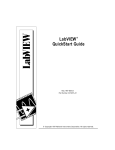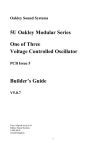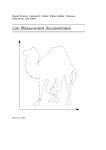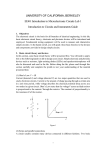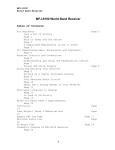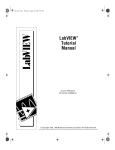Download VREF-399 User Manual
Transcript
VREF-399 User Manual Manual Revision (2010/01/15) Board Revision C Symmetric Research www.symres.com FREE WEB VERSION - PARTIAL CIRCUIT DIAGRAMS Contents 1 Introduction 3 2 Getting started 2.1 Overview . . . . . . . . . . . . . . . . . . . . . . . . . . . . . . . . . . . . . 2.2 Do’s and Don’ts . . . . . . . . . . . . . . . . . . . . . . . . . . . . . . . . . 5 5 6 3 Theory of operation 3.1 Overall design . . . . . . . . . . . . . . . . . . . . . . . . . . . . . . . . . . . 3.2 Operating tolerances . . . . . . . . . . . . . . . . . . . . . . . . . . . . . . . 7 7 8 4 Calibration 4.1 Production calibration . . . . . . . . . . . . . . . . . . . . . . . . . . . . . . 4.2 Calibration tags . . . . . . . . . . . . . . . . . . . . . . . . . . . . . . . . . . 10 10 11 5 Specifications 5.1 Specifications table 5.2 Short term noise . 5.3 Long term noise . . 5.4 Thermal response . 12 13 14 15 16 . . . . . . . . . . . . . . . . . . . . . . . . . . . . . . . . . . . . . . . . . . . . . . . . . . . . . . . . . . . . . . . . . . . . . . . . . . . . . . . . . . . . . . . . . . . . . . . . . . . . . . . . . . . . . . . . . . . . . . . . . . . . . . . . 6 Circuit Diagrams 7 Examples and Experiments 7.1 Connector options . . . . 7.2 Measuring the outputs . . 7.3 Negative voltages . . . . . 7.4 Potentiometer usage . . . 7.5 Differential applications . 7.6 A/D converter calibration 17 . . . . . . . . . . . . . . . . . . . . . . . . . . . . . . . . . . . . . . . . . . . . . . . . . . . . . . . . . . . . . . . . . . . . . . . . . . . . . . . . . . . . . . . . . . . . . . . . . . . . . . . . . . . . . . . . . . . . . . . . . . . . . . . . . . . . . . . . . . . . . . . . . . . . . . . . . . . . . . . . . . . . . . . . 20 21 22 23 24 25 26 8 Frequently Asked Questions 27 9 Extra supplies 9.1 Small parts for cables etc . . . . . . . . . . . . . . . . . . . . . . . . . . . . 29 30 2 Chapter 1 Introduction The Symmetric Research VREF-399 is a precision voltage reference suitable for general lab use and applications such as the DC calibration of high resolution A/D converters. The primary goal of the reference is to provide excellent long term stability with the same voltages returned from one power on cycle to the next. No trim pots have been used to avoid the stability problems they introduce. Six fixed output voltages are available on individual banana jacks. Each of the voltages is approximately one volt apart, with a calibration tag included for each system. The reference as a whole is floating. Any one of the outputs may be taken as ground, with the other outputs then distributed positive or negative from the grounded output. The system only requires power from a wall transformer and connections to the reference jacks for use. Among the leading features of the VREF-399 are: • LM399 heater stabilized buried zener design • Excellent short and long term stability • Six floating outputs in 1 volt increments • All outputs buffered with low noise op amps • Easy to use banana jacks for test leads and banana plugs • Perfect for calibrating 24 bit A/D systems • General lab usage includes potentiometer and sensor excitation • Test leads and wall transformer included We hope the VREF-399 is a useful tool for your applications 3 Typical VREF-399 usage photo: Figure 1.1: VREF-399 for A/D calibration One popular VREF-399 application is for calibrating precision A/D converters. In the photo above, the reference is connected to an SR USB4CH 24 bit A/D system. With the reference voltages you can measure the counts per volt, and with multiple jacks one volt apart you can also test linearity. Because the reference is floating, generating a negative voltage is as easy as a positive. Just reverse the leads. If grounding is necessary, simply connect any one of the banana jacks to the desired ground. The other jacks are then distributed positive and negative from the ground point. Besides being used as a reference, the system can be used as an excitation voltage for sensors like potentiometers. Each of the VREF-399 banana jacks is capable of supplying 10ma of current while remaining within specifications. The outputs are also tolerant of capacitive loads without oscillation. 4 Chapter 2 Getting started The VREF-399 is easy to use. The following covers the steps. 2.1 Overview Installation requires just plugging it in! The wall transformer should be plugged into wall power and its 2.1mm plug into the back of the VREF-399. Use only 12 vdc 500ma unregulated floating wall transformers as supplied with the system. Once plugged in, the green LED on the top panel will light up showing power has been applied. After a short warm up period, the VREF-399 is ready to use. Simply connect to any two banana jacks to get a constant voltage. The size of the voltage depends on which two jacks are selected. The further apart the jacks, the larger the constant voltage. The VREF-399 is based on a National Semiconductor LM399 voltage reference. This reference provides excellent long and short term stability by using a temperature controlled buried zener. Usually the heater will stabilized in a minute or two, but a warm up period of a half hour is best for the most precise results. The core LM399 reference voltage is scaled and buffered to provide the output voltages on the 6 banana jacks. Each jack is approximately 1 volt from the next. Because the system is floating, you can designate any one jack as ground. Then all the other jacks are measured relative to the jack taken as ground. For example, if banana jack 1 is taken as ground, then the voltage between jack 1 and 3 is +2 volts. The Examples and Experiments chapter reviews several typical applications. 5 Figure 2.1: VREF-399 banana jacks with low voltage on the left / high on right 2.2 Do’s and Don’ts Things to remember when using the VREF-399: • DO use the 12vdc 500ma wall transformer supplied with the system. This ensures the reference is floating and there is enough headroom for the internal op amps. • DO give the VREF-399 a few minutes to a half hour of warm-up to reach thermal equilibrium and provide repeatable voltages. • DON’T use power supplies that are grounded or are connected to the third prong on the wall power (wall ground) because the VREF-399 will no longer be floating! • DON’T connect two different banana jacks to ground at the same time. Doing so will short the outputs and draw excessive current. • DON’T connect the banana jacks to low resistances. The VREF-399 can supply a maximum current of 10ma on any one of its banana jacks and still maintain its specifications. For best precision keep output loading greater than 100 ohms. 6 Chapter 3 Theory of operation 3.1 Overall design The core of the VREF-399 is comprised of a precision LM399 reference followed by a resistor ladder to generate multiple voltages. The LM399 is a lab grade semiconductor reference with a nominal 7 volt output, and is generally thought of as one of the best semiconductor references available. Its heater stabilized buried zener design guarantees the same voltage from one power on cycle to the next. While other semiconductor reference technologies such as bandgap references offer lower power consumption, they cannot match the LM399 for repeatable performance and stability without hysteresis. Following the LM399 is a resistor ladder which generates the multiple core VREF-399 outputs which are further op amp buffered for the top panel banana jacks. The design first reduces the LM399 output to 5 volts, and this is applied to a ladder of 5 equal resistors to generate the 1 volt increments. Precision metal thin film resistors are used, with the essential circuit shown in Figure 3.1 on the following page. The dark arrowheads represent each output buffer and banana jack, and (V 1 . . . V 5) are the voltages between adjacent pairs of jacks. Note the circuit fragment does not show any ground connection. The VREF-399 is floating and can be reference to any ground desired. Any single one of the banana jacks can be connected to your system ground, and then the remaining jacks will be distributed positive and negative from that ground referenced point. This allows for very flexible usage depending on the application. The op amp output buffering can supply 10ma per jack, isolating the core resistor ladder from user applications. The design does not include any trim pots that could compromise thermal or long term stability. The concept is to accept any initial tolerances, record the outputs, and then to have their values be the same from one power on cycle to next in any thermal environment. The advantages of this repeatability make avoiding the uncertainty of trim pots worth not 7 being trimmed to exactly 1 volt increments. A calibration tag is included with each system reporting the banana jack voltages at the time of production. The initial tolerances and the deviations from 1 volt increments are discussed in the next section. Master reference = 5 volts ( +/-5%, 2ppm/C ) ( floating LM399H ) R R R R R V1 V2 V3 V4 V5 all R = 1K ( +/-0.05%, 10ppm/C ) Figure 3.1: VREF-399 output voltages 3.2 Operating tolerances Although the core LM399 reference is extremely stable with respect to temperature and time, its initial voltage tolerance is accurate only to within 5% across different parts. This means the 5 volts shown across the resistor ladder in the circuit fragment above may vary from 4.75 to 5.25 volts depending on the LM399 in your unit. Any given VREF-399 will have a voltage somewhere in this range between its highest and lowest banana jack that will not change with time or temperature. Since the resistors in the ladder all have the same value, this also means the initial 5% LM399 uncertainty will result in 0.95 to 1.05 volts between any pair of adjacent banana jacks. This 5% initial overall tolerance is reported as Vjacks in the Specifications table, and is the primary contribution to deviation from exactly 1 volt increments between the jacks. A much smaller deviation from 1 volt increments is contributed by the tolerances of the resistor ladder itself. Precision resistors with 0.05% initial tolerance are used. This means 8 the voltage between one adjacent pair of jacks to the next will be the same to within 0.05%. For example, if the LM399 voltage across the resistor ladder was 5 volts, then the nominal increments between the jacks would be exactly 1 volt assuming perfect resistors. Resistor tolerances would affect this value from one adjacent pair of jacks to the next to be between 0.9995 and 1.0005 volts. Once you determine the voltage between one pair of jacks, the value between other adjacent pairs will deviate by at most 0.05% = 500 ppm or 500 microvolts. This variation in voltage from one adjacent pair of jacks to the next is reported as ∆Vjacks in the Specifications table. The exact voltages for a particular VREF-399 are reported on the calibration tag. 9 Chapter 4 Calibration 4.1 Production calibration The VREF-399 is calibrated at the time of manufacturing. The calibration procedure is as follows: • An HP34401A 6 digit voltmeter is used for voltage measurement • The VREF-399 is powered from a 12v 500ma wall transformer (110vac/60Hz) • Both the VREF-399 and HP34401A are given a one hour warm up period • Voltage measurements are then taken referenced from the lowest banana jack • The same measurements are taken with the HP34401A voltmeter leads reversed • Measurements are repeated three times at one hour intervals • Results are averaged and a calibration tag is then included with the system No other record of the calibration is provided with the system. If you loose your calibration tag, follow steps similar to the above to recalibrate the system. You may also wish to write out custom tags for particular applications, measuring the voltages with respect to various jacks grounded. Blank tags are on the following page. Symmetric Research also attempts to keep calibration information for shipped systems on record. Contact us and we may be able to help. 10 4.2 Calibration tags The figure below is a copy of the file Tag.pdf. Print out either this page or the pdf file to make your own custom calibration tags. When printing, turn off Acrobat page scaling so the tags print at full scale to correctly fit on the top panel near the jacks. Print on index card stock available at office supply stores and trim apart with scissors. Several blank tags are also included with the system for your convenience. Write down the voltages with respect to the jack you typically take as ground. Figure 4.1: Calibration tags 11 Chapter 5 Specifications The table on the following page lists the leading VREF-399 specifications. Several of the performance parameters are also discussed in the Theory of operation chapter. A few of the primary analog components used in the design are listed in the small table below. Component specification sheets are also included with the distribution CDROM. Voltage reference Resistor ladder Output opamps = = = LM399H RG1608N-1.0K-W-T1 OPA2277UA 12 (National Semiconductor 5%) (Susumu RG 0.05%) (Texas Instruments) 5.1 Specifications table Parameter Comment VREF-399 Specs Min Reference: Vjacks ∆Vjacks variation Noise floor LM399 thermal stability R ladder thermal stability one pair to next short term long term long term Output characteristics: Output current (1) Voltage drop Capacitive loading maximum 10ma, 100 ohm load without oscillation Power supply: Voltage (2) Current Current (3) Warm-up time 0.95 Typ Max Units 1 0.05 1.05 5 2 10 V % µV ppm per ◦ C ppm per ◦ C 10 20 10 mA µV µF 30 200 Vdc mA mA hour 70 ◦ C inches 0.3 14.7 initial turn on operating General: Temp range Dimensions 17 140 60 0.5 0 2.5 x 5 Figure 5.1: VREF-399 specifications table (1) If more than 10ma is drawn from a banana jack, the output voltage may begin to drop and no longer remain constant, falling out of spec. Outputs are short circuit protected with current limiting at approximately 35ma. (2) Use only wall transformers that are floating and NOT connected to ground via the third wall prong as this would compromise the floating nature of the VREF-399. Also note the 12vdc 500ma unregulated wall transformer supplied with the system will normally provide 17 volts when loaded with the normal 60ma operating current drain of the VREF-399. (3) Normal power supply current is achieved about 2 minutes after the device is turned on. The LM399 heater normally consumes around 30mA and maintains a temperature of 90◦ C, almost the temp of boiling water. At lower ambient temps the LM399 heater will require more power to maintain 90◦ C, while at higher ambient temps it will require less. 13 5.2 Short term noise Work underway . . . short term noise plot Figure 5.2: VREF-399 short term noise 14 5.3 Long term noise Work underway . . . long term noise plot Figure 5.3: VREF-399 long term noise 15 5.4 Thermal response Work underway . . . thermal response plot Figure 5.4: VREF-399 thermal response 16 Chapter 6 Circuit Diagrams FREE WEB VERSION - PARTIAL CIRCUIT DIAGRAMS This free web copy of the User Manual includes only the Circuit Overview and connector assignments. Complete circuit diagrams are provided only with purchase of the product. Install the CDROM that came with the product shipment for the full User Manual with complete diagrams. Customers who need an update or have lost their original CDROM may obtain copies of the full User Manual by emailing Symmetric Research. Use the Adobe Acrobat reader View/Rotate View/Clockwise command to present the diagrams horizontally on the screen. Circuit Overview . . . . . . . . . . . . . . . . . . . . . . . . . . . . . . . . . . . . . . . . . . . . . . . . . . . . . . . . . . . . 18 Banana jacks . . . . . . . . . . . . . . . . . . . . . . . . . . . . . . . . . . . . . . . . . . . . . . . . . . . . . . . . . . . . . . . . 19 17 18 1 2 3 4 B (100) A B SERIAL NUMBER AND CALIBRATION STORAGE FACTORY USE ONLY SCHEMATIC PAGE 10 EEPROM LINEAR REGULATION FOR LOW NOISE 2.1mm POWER CONNECTOR (400) 12 VDC 500ma FLOATING WALL TRANSFORMER REQUIRED SCHEMATIC PAGES 7-9 POWER SUPPLY C (900) (200) Title Date: Size A D Wednesday, November 07, 2007 Sheet Document Number VREF-399.DSN, (c) Symmetric Research, 2007 01 OVERVIEW FLOATING OUTPUTS 1 E BANANA JACK FOR EACH OUTPUT OUTPUTS IN 1 VOLT INCREMENTS SCHEMATIC PAGE 6 6 OUTPUTS AVAILABLE SCHEMATIC PAGES 3-5 E LOW NOISE OPA2277 BUFFERS OUTPUT CONNECTORS D LM399 WITH HEATER OUTPUT BUFFERS C SCHEMATIC PAGE 2 PRECISION REFERENCE SR VREF-399 BLOCK DIAGRAM OVERVIEW A of 10 (300) Rev C 1 2 3 4 19 1 2 3 4 B A J311 BRACKET FRONT PANEL 1 B J310 BRACKET BACK PANEL 1 FROM OUTPUT BUFFERS REFERENCE OUTPUT BANANA JACKS A VBREF0 VBREF1 VBREF2 VBREF3 VBREF4 VBREF5 C C 1 1 1 1 1 1 J300 J301 J302 J303 J304 J305 BANANA JACK BANANA JACK BANANA JACK BANANA JACK BANANA JACK BANANA JACK Date: Size A Title D Wednesday, November 07, 2007 Sheet Document Number VREF-399.DSN, (c) Symmetric Research, 2007 06 ANA OUTPUT CONNECTOR ALL OUTPUTS FLOATING VBREF0 VBREF1 VBREF2 VBREF3 VBREF4 VBREF5 D 6 E E of 10 Rev C 1 2 3 4 Chapter 7 Examples and Experiments The following are some examples of how to use the VREF-399: . Connector options ways to connect to the banana jacks . Measuring the outputs using a Fluke meter to measure the reference . Negative voltages how to use the floating outputs . Potentiometer usage providing excitation voltages for sensors . Differential applications noise reduction with differential signals . A/D converter calibration calibrating differential A/D inputs 20 7.1 Connector options There are several ways to use the VREF-399 banana jacks. The best one to use depends on the equipment you are working with. The following photos show some of the possibilities. Figure 7.1: VREF-399 with banana plugs installed Figure 7.2: VREF-399 with alligator leads installed 21 7.2 Measuring the outputs The six constant voltages on the banana jacks range from 0 to 5 volts in increments of approximately 1 volt. With no trim pots, the system has excellent long term stability. But in return, the output voltages are not trimmed to integral values such as 3.00000 volts and may have values such as 2.98786 volts. A measurement of the voltages is done at the time of production, and the results are printed out on a calibration tag. You can repeat the calibration yourself if you have access to a precision voltmeter. Meters such as the Fluke 170 series are also acceptable for many applications. Uncertainty in the initial absolute voltage at any banana jack is a different issue than the long term stability. With the VREF-399 as its source, an A/D converter should return the same count results each time a calibration is performed. An example of measuring a positive voltage is shown in the following figure. In this setup, a Fluke meter is used to measure the voltage between jacks 1 and 4. Since there are three jacks between the red and black leads, the meter reads approximately 3 volts. The 2.988 volts shown is within the absolute VREF-399 specification. Figure 7.3: Generating +3 volts 22 7.3 Negative voltages Besides positive voltages, the VREF-399 can also generate negative voltages. Because the reference is floating and not tied to a system ground, any of the jacks can be taken as ground. The figure below shows the setup for providing a constant minus 3 volts. Even though the Fluke meter is floating, the jack with black test lead could be connected to your system ground because the VREF-399 is not ground referenced either. With the red test lead on a lower jack a negative voltage is supplied. You can see the meter does not read exactly minus three volts, but is within the accuracy specification. What you will find is exactly the same -2.988 voltage is returned from one power on to the next. Figure 7.4: Generating -3 volts 23 7.4 Potentiometer usage The VREF-399 can be used with a 10 turn potentiometer to generate small increments in voltage for testing at low voltages. Work underway . . . 24 7.5 Differential applications The VREF-399 is perfect for use with systems having differential inputs. Differential connections are very effective techniques for dealing with ground loop currents and noise. Work underway . . . 25 7.6 A/D converter calibration The physical quantity intrinsically measured by most A/D systems is voltage, where a corresponding digital count value is returned to the computer. Low input voltages return a low count value, and as the voltage grows so does the count value. The relationship between an input voltage and the output counts is referred to as the DC Calibration of the A/D system, and is commonly modeled by a straight line with a slope and offset. Determining the slope and offset of this line is the goal of calibration. Deviations from a straight line characterize the nonlinearity of the system. The VREF-399 can be used to perform A/D calibration by supplying several constant voltages. For each voltage, acquire some data and then use the (voltage,count) pairs to fit the best possible straight line. The resulting line will relate any particular output count to an input voltage. Because the VREF-399 is an independent stand alone reference, it provides an absolute calibration standard. With its buried zener design and heated thermal stabilization, the LM399 reference is considered one of the best semiconductor references available and will provide repeatable measurements. Work underway . . . 26 Chapter 8 Frequently Asked Questions The following FAQ may help if you have general questions about the VREF-399. What is a buried zener ? Common zener diodes have their junction exposed to the surface of the silicon substrate. For such diodes, surface currents and oxidation compromise the short term noise and long term stability of the diode. Buried zeners place the junction below the substrate surface to avoid these effects. The technique works well, with buried zeners recognized as one of the best semiconductor reference technologies available. The performance of a buried zener is further enhanced when thermally stabilized as with the LM399. What kind of power supplies can I use for the VREF-399 ? Be sure to use a standard unregulated wall transformer that is connected to wall power with only two prongs as is supplied with the system. If you use a power supply that is grounded to the third prong on the wall socket, or other form of system ground, then the VREF-399 will be referenced to that ground and no longer be floating. Can I really ground any of the six banana jacks ? Yes. You can connect any one of the six banana jacks to your system ground. The remaining jacks will then be at approximately 1 volt increments positive and negative from the grounded jack. Do not ground more than one jack at a time. Doing so shorts jacks together drawing excessive current. 27 I have lost my calibration tag, what can I do ? The best approach is to re-measure the voltage at each jack and write a new calibration tag. See the Calibration tags section for blank tags. SR attempts to maintain calibration records. Contact us by email if you need help. The product serial number will be required. What affects voltage accuracy ? For precise measurements at microvolt levels, the main culprit compromising accuracy is voltage drops due to wiring. The feedback point for the op amps driving the jacks is placed exactly at the banana jacks. Drawing 10ma from a jack will not effect the voltage at the jack to within specifications. However, if you connect to the jacks through long wires, and then draw 10ma, the voltages at the ends of your wires will be off by the amount dictated by Ohm’s law. In those cases, keep your wires short and draw as little current as possible. Typically 24 gauge stranded wire has a resistance of approximately 20 ohms per 1000 feet. So, a one foot length with a resistance of 0.02 ohms and a 10ma current would have a V = IR = 0.0002 voltage drop. Depending on the application, this may represent a significant error. Clearly with 100 feet of wire the error becomes even larger. For ease of use, the VREF-399 does not have separate Kelvin connections. The Kelvin points are at the banana jacks, and voltages are maintained at those points with the specified accuracy. Besides voltage drops due to wiring, sometimes thermocouple effects between metal junctions is a concern. One way to address such problems is to make differential measurements and ensure the same number of thermocouples occur in each side of the differential pair. See the Differential applications section. Are the voltage increments between jacks exactly 1 volt ? No. They are only approximately one volt apart, where approximately means to within the specified absolute accuracy. To avoid problems with long term drift, the VREF-399 does not have any trim pots. The goal of the device is to provide the same voltages at the banana jacks from one power on to the next over long periods of time. Use the production calibration info supplied with the system to scale A/D counts and similar measurements into exact counts/volt etc. 28 Chapter 9 Extra supplies Extra basic supplies such as cable and connectors may be required depending on the VREF-399 application. SR can often provide such supplies on request, however many customers may want to purchase such parts directly from suppliers themselves. This chapter lists a few typical parts and vendors. The list is only representative with many other suppliers providing equally good products. DigiKey www.digikey.com 1(800)344-4539 Mouser Electronics www.mouser.com 1(800)346-6873 JDR Microdevices www.jdr.com 1(800)538-5000 Abbreviations used below: MFG = Manufacturer DK = DigiKey MO = Mouser JDR = JDR Microdevices 29 9.1 Small parts for cables etc Some of the more common parts used in VREF-399 applications are as follows: Alligator clips MFG part number = Mueller BU-30 DK part number = 314-1010-ND MFG part number = Silvertronic 501793 MO part number = 835-501793 The Mueller BU-30 clip has a good spring and strong teeth. The connection is wire crimp, which should also be soldered for low resistance. Making cables with these clips requires skill, but they result in inexpensive connections of good quality that are easy to use. The Silvertronic part is equivalent to the Mueller. Johnson banana plugs MFG part number = Johnson (Emerson) 108-753-001 DK part number = J149-ND MO part number = 530-108-0753-1 These uninsulated banana plugs have a 6-32 screw in the end. When plugged into VREF-399 banana jacks, they provide screw terminal connections. Solder terminal lugs for Johnson banana plugs MFG part number = Keystone 7329 DK part number = 7329K-ND MO part number = 534-7329 The Keystone solder lugs are useful for making screw terminal connections to the Johnson banana plugs. It is also easy to clip alligators onto these lugs when they have no wire soldered on. The lugs listed above are flat. Lugs with internal tooth lock washer holes are also available for even more secure connection. Pomona test leads MFG part number = Pomona 5519A DK part number = 501-1004-ND MO part number = 565-5519A To use these test leads with the VREF-399 you must trim or cut away the banana plug insulating shroud. Do this with a utility knife or razor blade carefully cutting away the plastic shroud. 30 Twisted pair shielded cable MFG part number = Belden 9501 MO part number = 566-9501-100 Twisted pair provides reasonable powerline noise immunity. This Belden cable also has a foil shield and is jacketed. There are a large number of cable types available. The above is only one example. Potentiometers, 10 turn, 10K ohm MFG part number = Vishay (Sfernice) 53411103 MO part number = 594-53411103 MFG part number = Bourns 3540 series DK part number = 3540S-1-103-ND A 10 turn pot is a simple and reasonably accurate sensor to use when testing the VREF-399. There are many manufacturers of 10 turn pots. A 10K ohm unit will not draw excessive current from the VREF output. Wall transformers MFG part number = Xicon MO part number = 412-112054 (12vdc 500ma 2.1mm plug, 110vac input ** US) Don’t use switching regulated wall transformers with the VREF-399. They will introduce considerable high frequency noise into the system. Use only floating unregulated linear wall transformer. Be sure to use a 12 volt 500ma unit. 9 volt units are not acceptable. Do not daisy chain the wall transformer to other equipment creating unexpected ground connections. 2.1mm power plug MFG part number = CUI Inc PP3-002A DK part number = CP3-1000A MFG part number = Kobiconn MO part number = 1710-2131 These are discrete wire power plugs suitable for soldering wires to. They are useful for connecting batteries and other custom power sources to the VREF-399. Use these instead of chopping the plug off your wall transformer. 31 Batteries, 12 volt lead acid MFG part number = BB Battery BP1.2-12-T1 (12v 1.2Ah) DK part number = 522-1007-ND MFG part number = Power Sonic (12v 1.4Ah) MO part number = 547-PS-1212 These are small lead acid batteries. Running the VREF-399 from batteries may be of interest for the ultimate in a floating reference. A 1.2 Ah battery would have enough power to run the VREF-399 continuously for approximately 1.2/0.060 = 20 hours. Enough time to do some reasonable work. Lead acid batteries are rechargeable. 32 Getting Technical Help Answers to many general questions as well as resources such as application notes can be found on our web site. If you have additional technical questions, please email us: General product information: www.symres.com SR technical help email address: [email protected] 33 Trees are green Yakima, Washington, May 2006 VREF-399 User Manual c , Symmetric Research, 2006, 2010 Copyright This material can only be reproduced in whole or part with the written permission of Symmetric Research No guarantee of suitability for any application is made with this document All liabilities are the responsibility of the user Email: [email protected] Web: www.symres.com 34












































